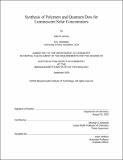Synthesis of polymers and quantum dots for luminescent solar concentrators
Author(s)
Achorn, Odin B.(Odin Bnejamin)
Download1227521742-MIT.pdf (3.402Mb)
Other Contributors
Massachusetts Institute of Technology. Department of Chemistry.
Advisor
Moungi G. Bawendi.
Terms of use
Metadata
Show full item recordAbstract
In order to meet the world's increasing energy demands, we must develop innovative ways of harnessing renewable energy. Benefits can be achieved by supplementing direct photovoltaic technologies with building-integrated photovoltaics, which take advantage of existing infrastructure. For example, luminescent solar concentrators (LSCs) are semitransparent devices that harvest sunlight and redirect it toward photovoltaic cells. Because of their semitransparent nature, LSCs can be used as windows, highway noise barriers, and greenhouse walls to convert these passive structures into energy harvesters. In the first part of this thesis, we describe the design of thin-film quantum dot (QD) LSCs, which can be deposited on existing transparent structures in the built environment. In order to disperse the thick-shelled CdSe/CdS QDs at a high concentration, we designed and synthesized a new polymer bearing carboxylic acids. The resulting film of the polymer/QD composite is highly concentrated and low scattering, and the high quantum yield of the QDs is retained. We also use a Monte Carlo simulation to predict the benefits of creating a two-layer device with both CdSe/CdS QDs and Lumogen F Red 305. In the second part of this thesis, we introduce our development of new less toxic QDs to replace CdSe/CdS QDs in LSCs. These new QDs are based on InP, and our first task was to extend their absorption band by developing a new synthetic technique to access large sizes. This technique consists of the slow injection of phosphorus precursors into a reaction mixture of indium precursors. By controlling the injection rate, we accessed large sizes and low size dispersity. In the third part of this thesis, we addressed reabsorption losses in InP QDs as LSC fluorophores. We did this by introducing silver dopants to the InP QDs, which redshift the emission from the absorption. We improved the quantum yield of these silver-doped InP QDs by adjusting the number of silver dopants per QD and by adding thiols as ligands. Finally, we used our Monte Carlo simulation to predict the performance of these QDs relative to CdSe/CdS QDs in LSCs.
Description
Thesis: Ph. D., Massachusetts Institute of Technology, Department of Chemistry, September, 2020 Cataloged from student-submitted PDF of thesis. Includes bibliographical references (pages 129-135).
Date issued
2020Department
Massachusetts Institute of Technology. Department of ChemistryPublisher
Massachusetts Institute of Technology
Keywords
Chemistry.